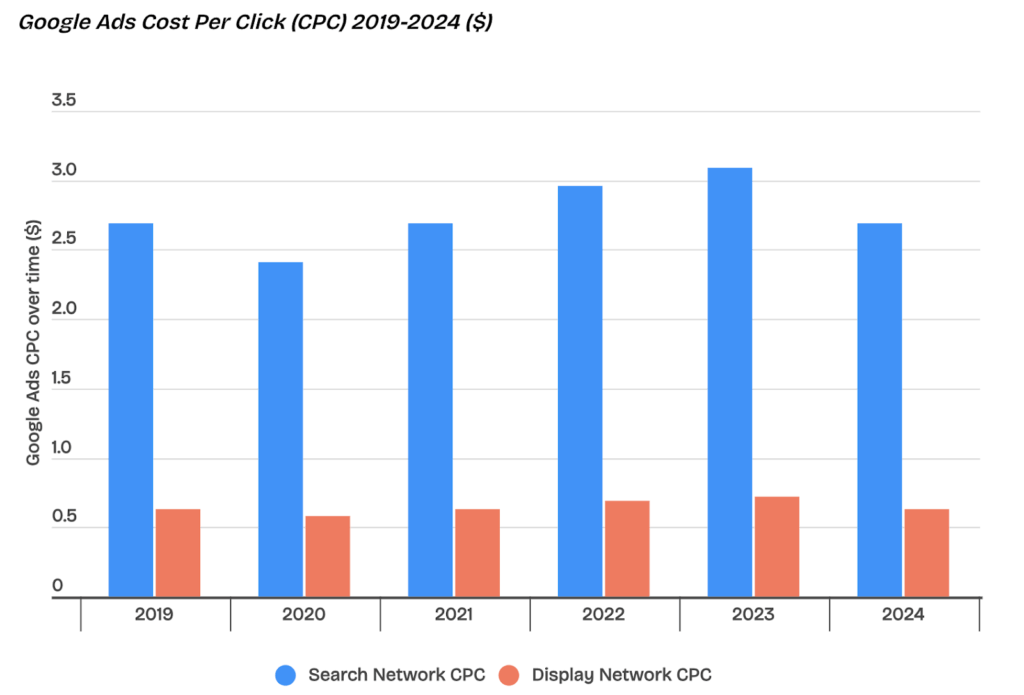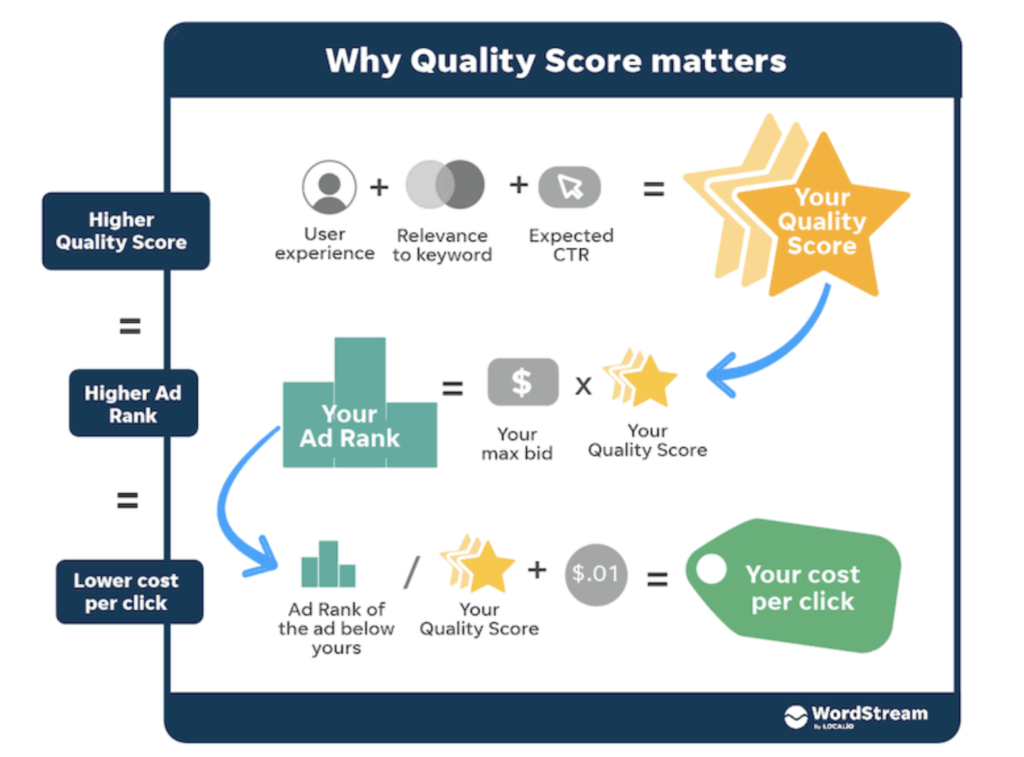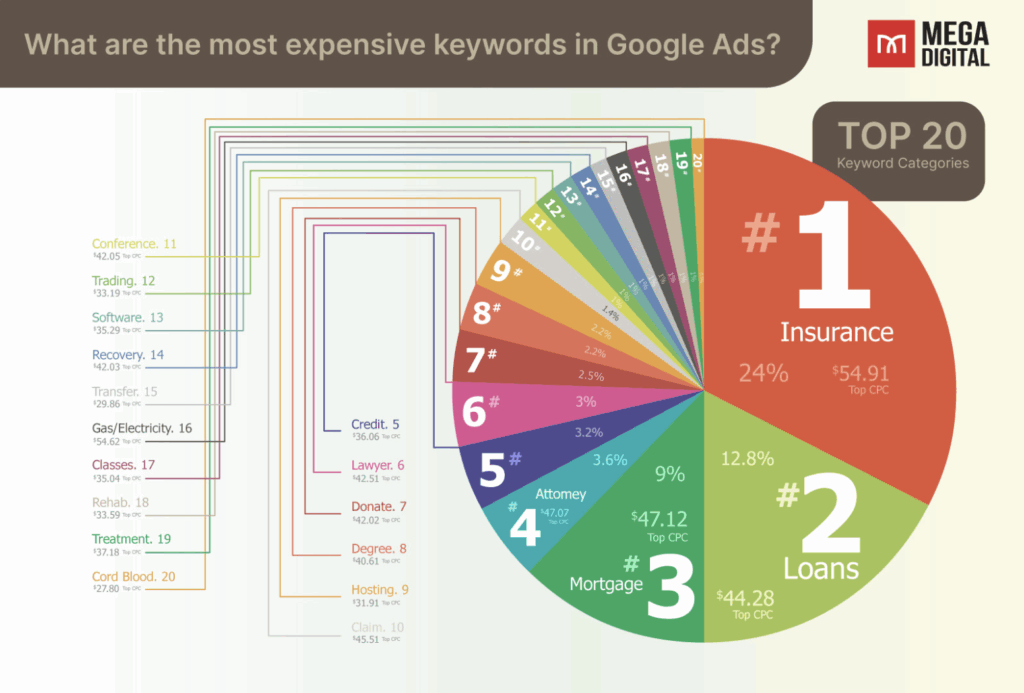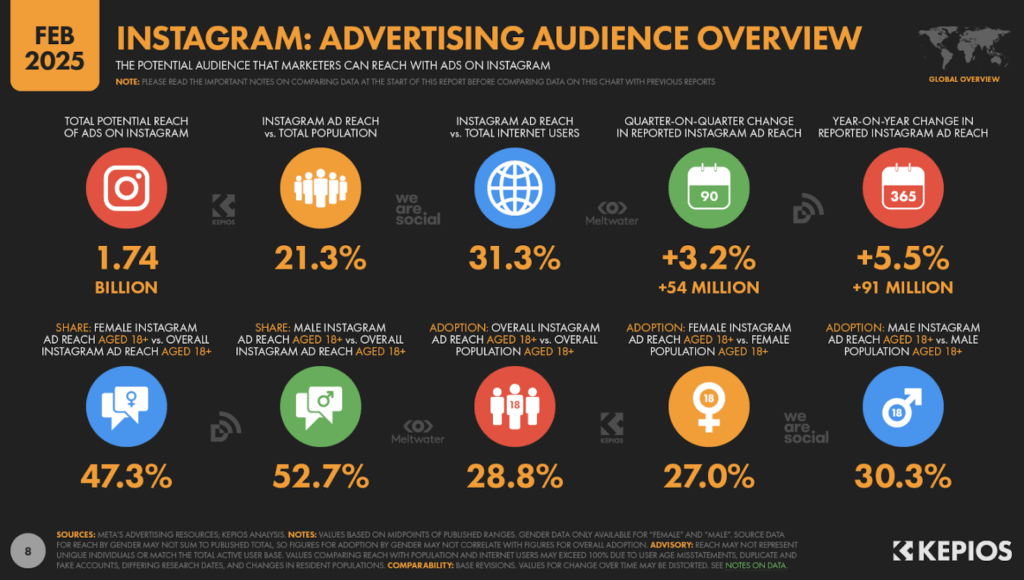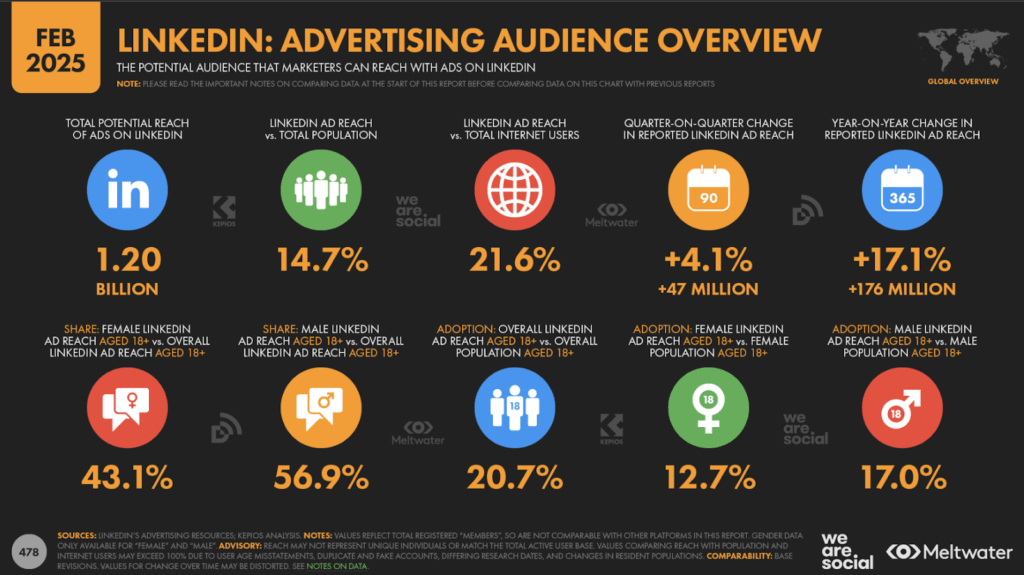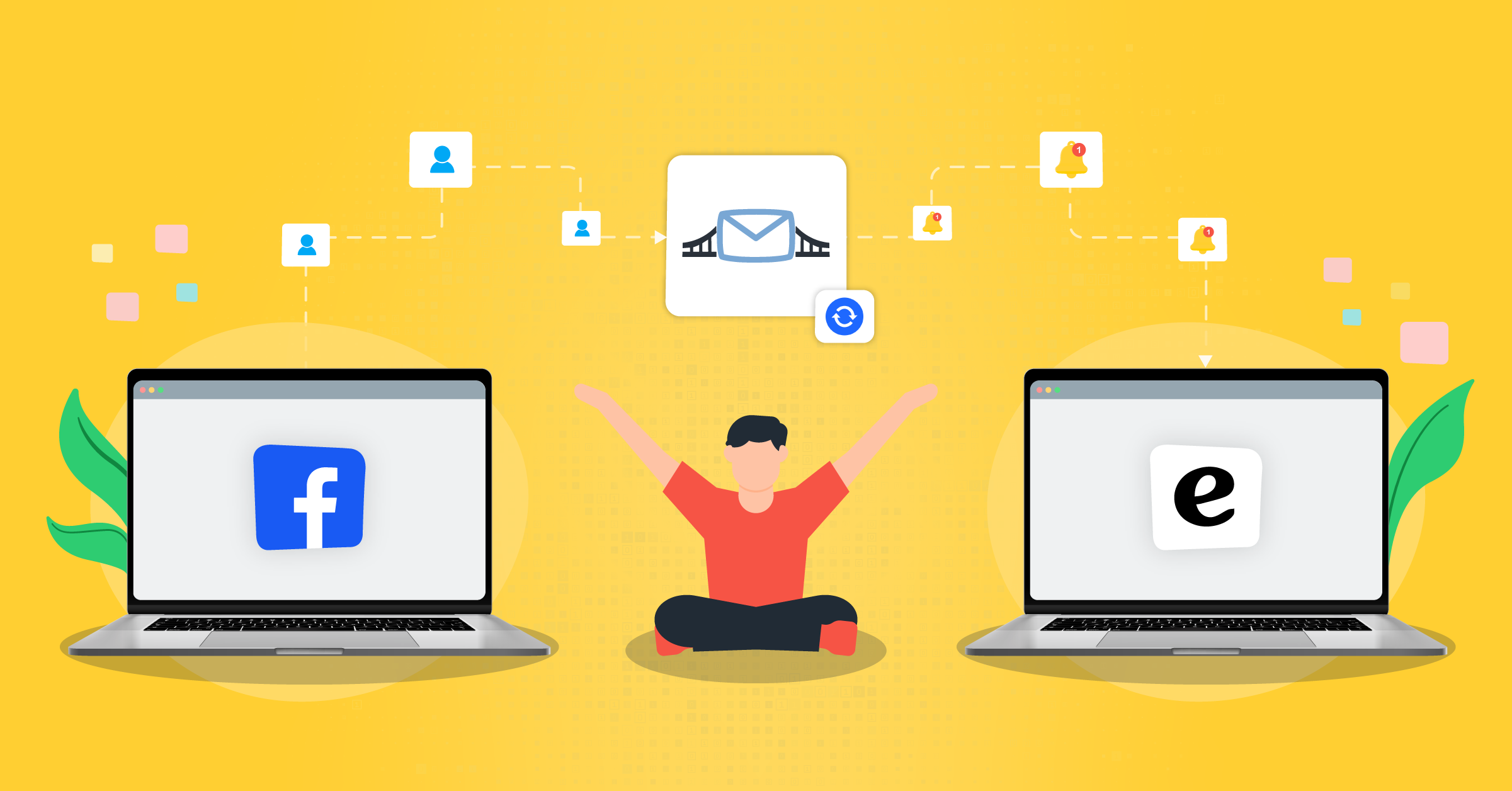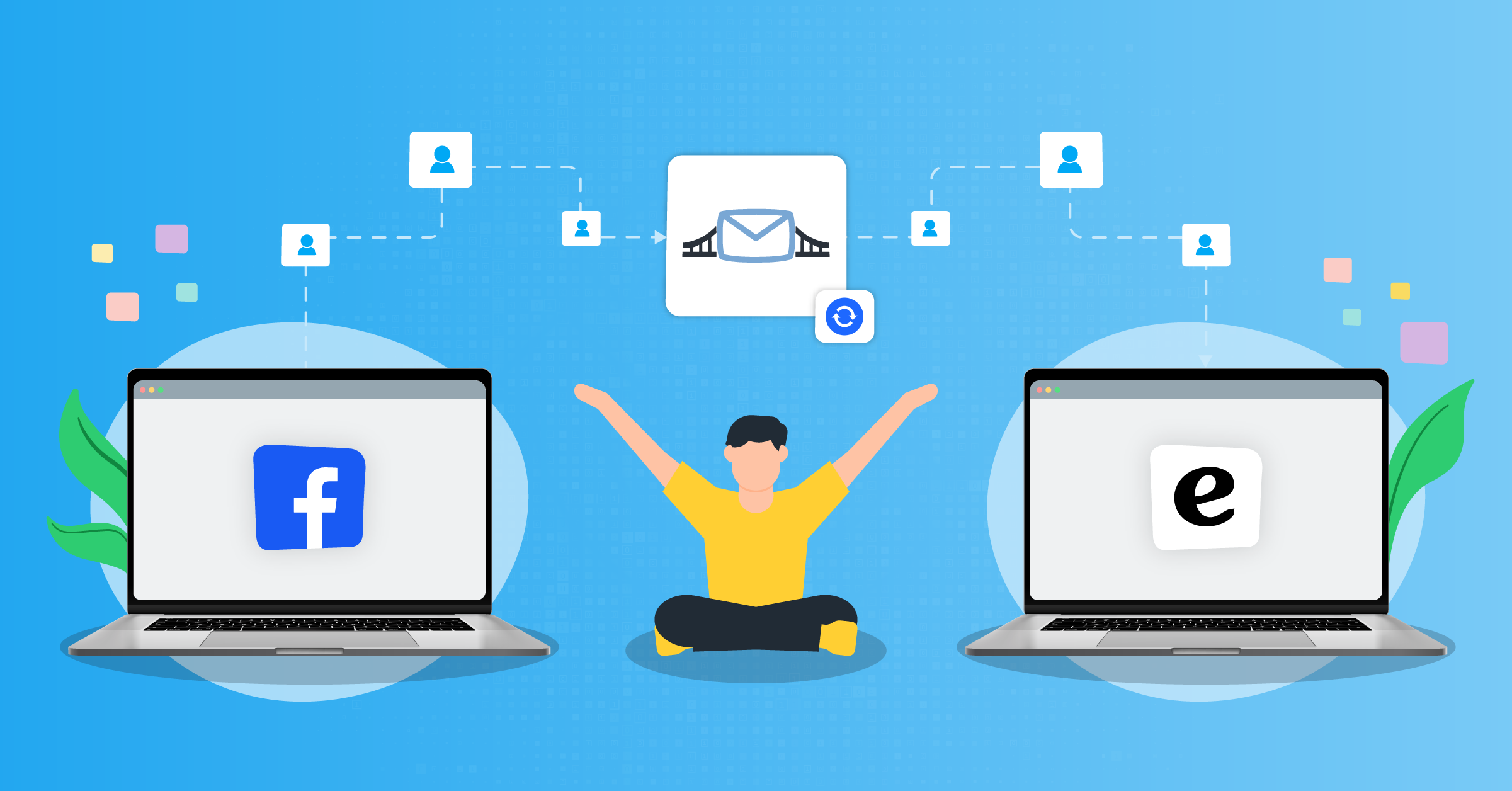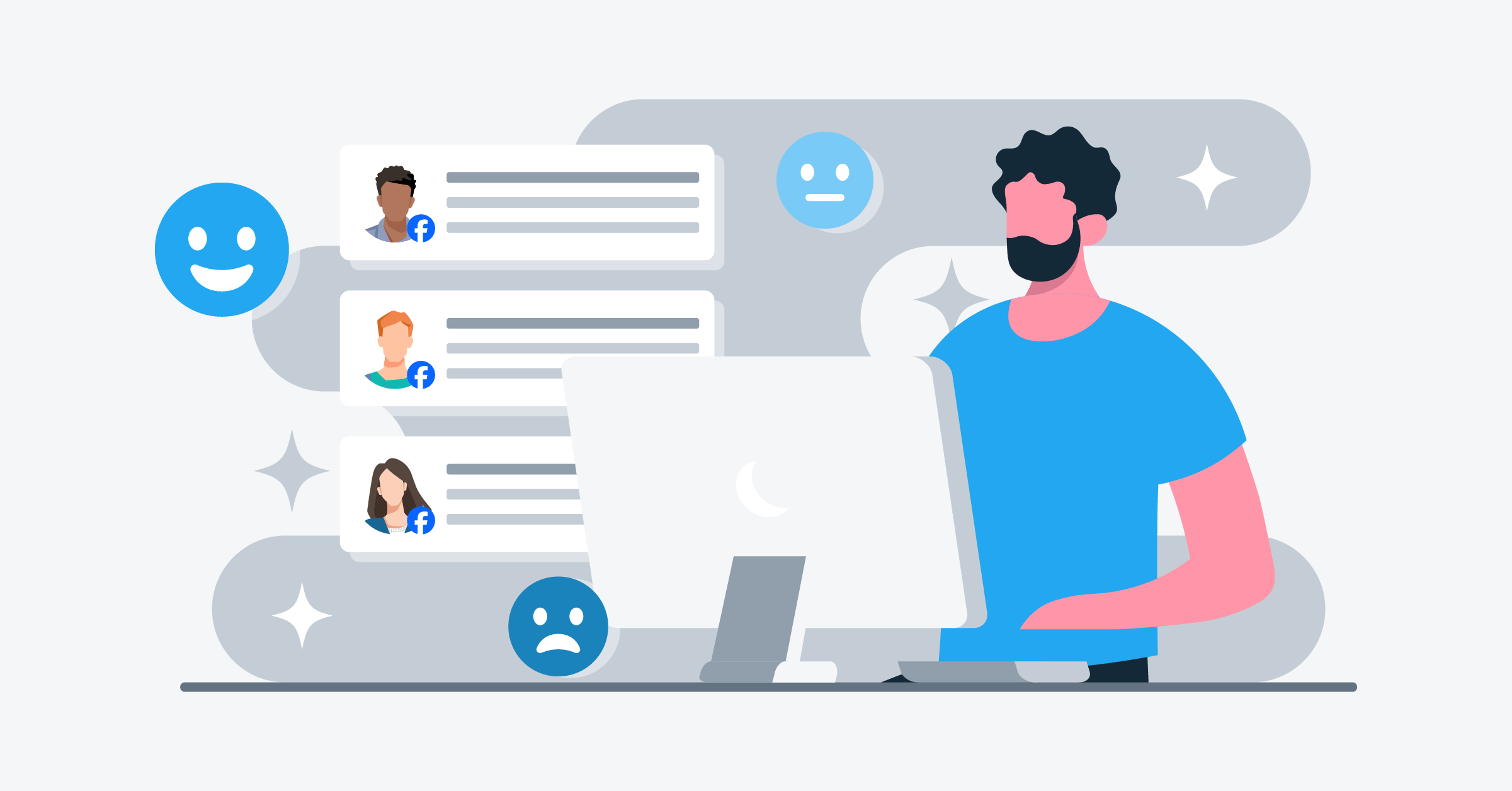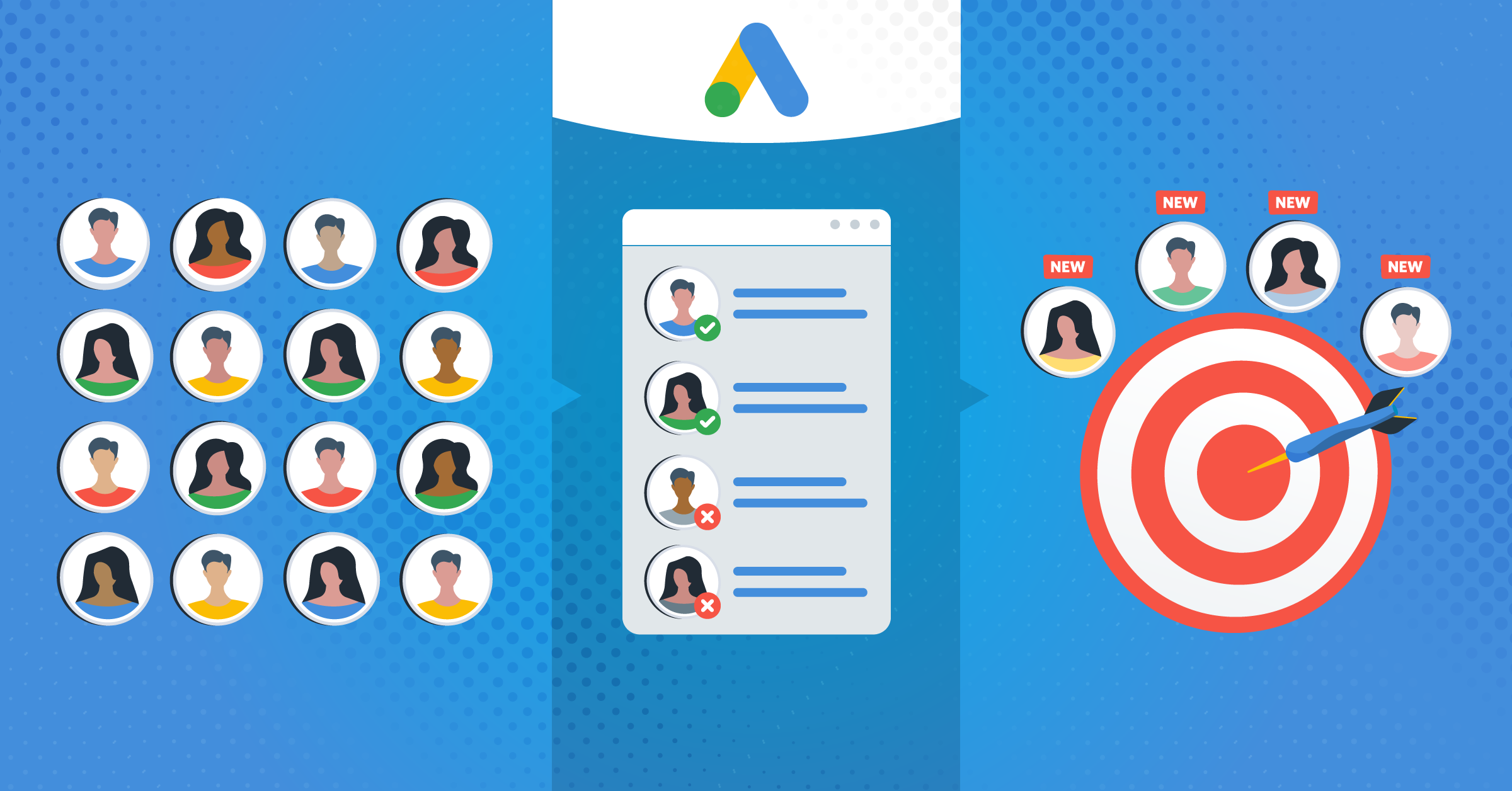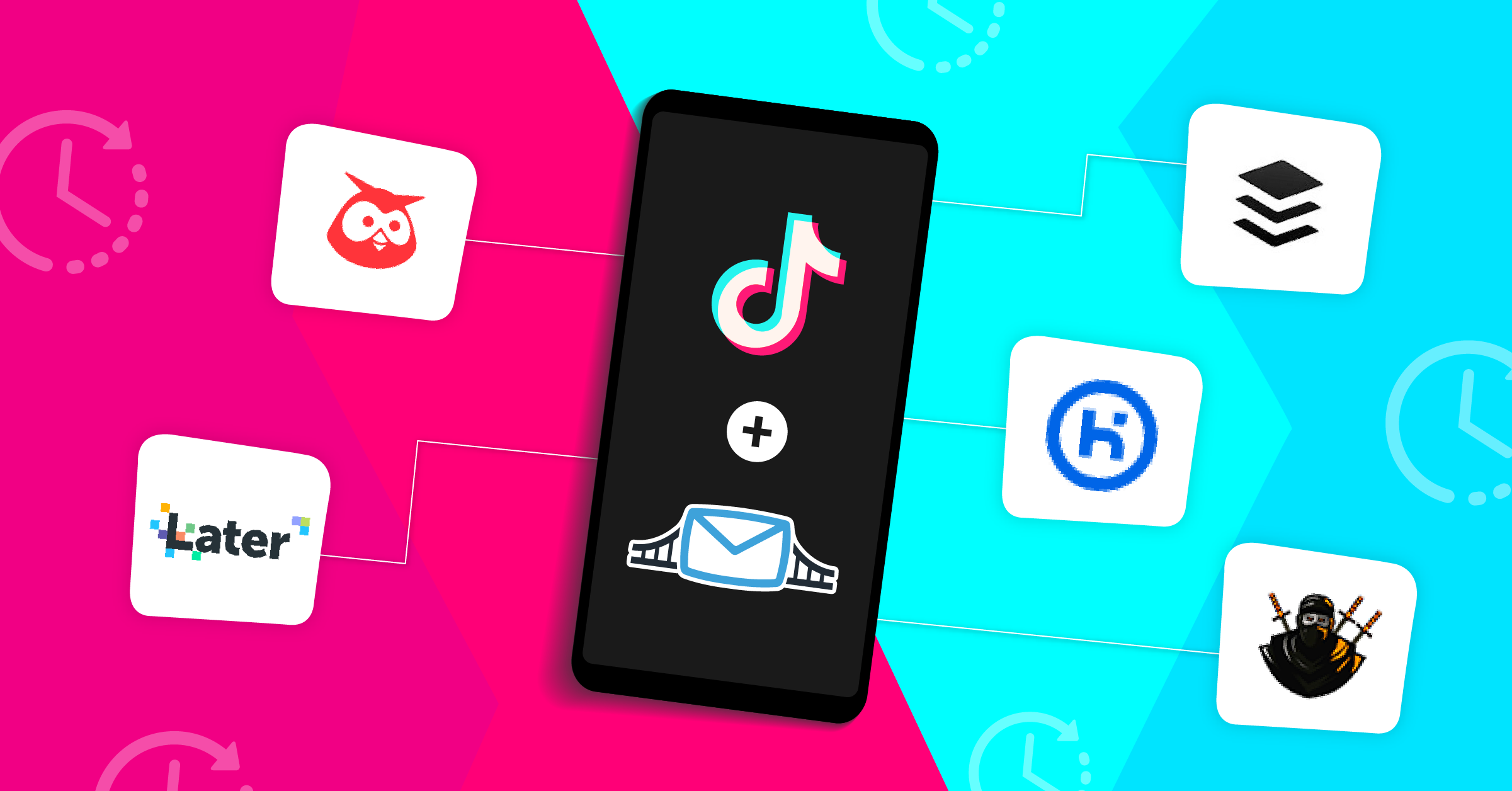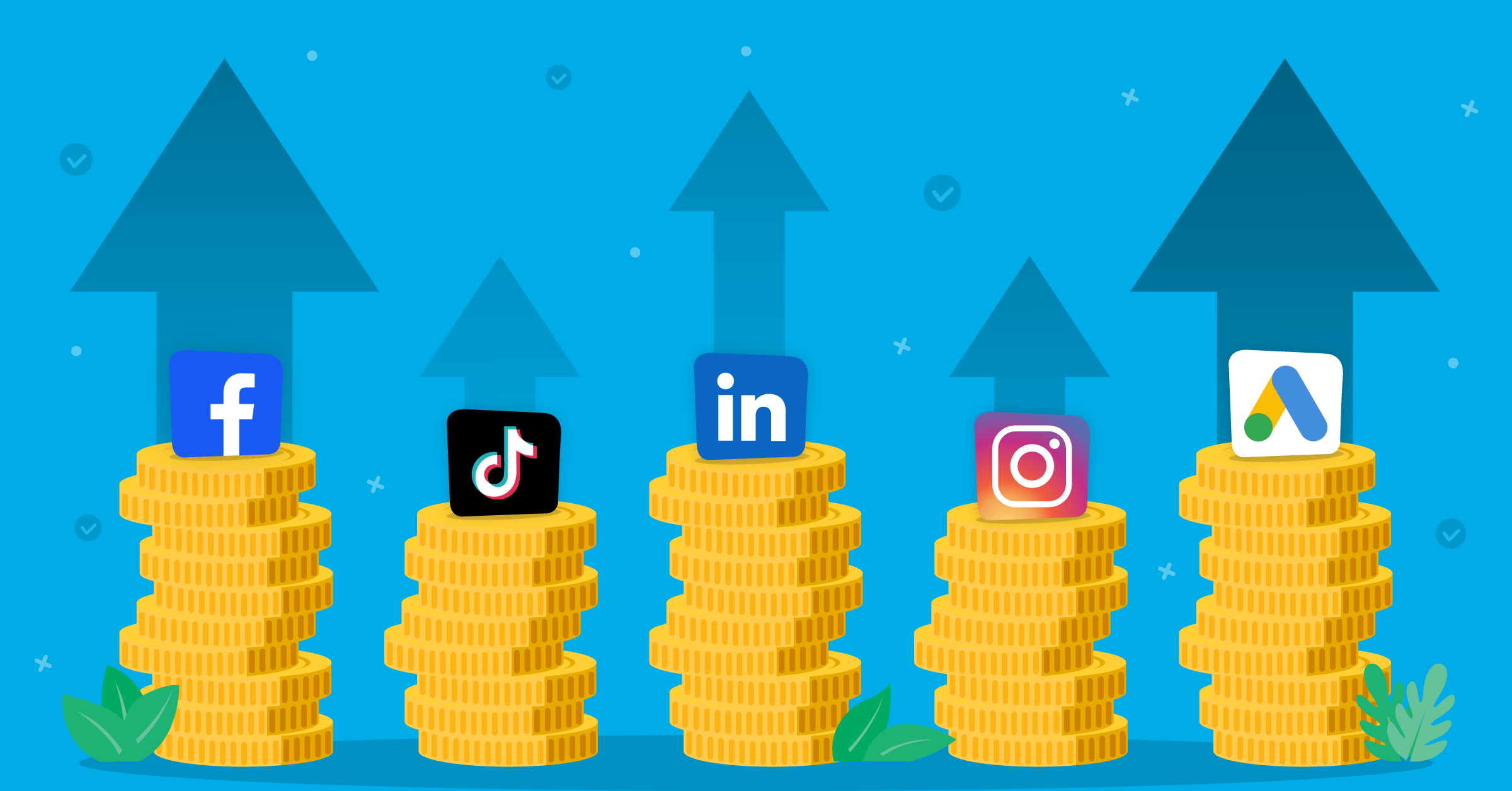
There’s no one-size-fits-all solution for advertisers. Strategies can cover a whole range of efforts. Anything from increasing online ad budgets to boost revenue to cutting ad spending to save costs.
Despite the strategy, all successful campaigns share a general formula: investing in digital channels, targeting the right audience, and leveraging various platforms.
The leading ad platforms—Google, Facebook, Instagram, LinkedIn, TikTok, Snapchat and YouTube—each have unique benefits and drawbacks. So the cost of online advertising also varies depending on the platform, industry competition, ad quality, and relevance.
Choosing the right automation tools makes all the difference. For instance, LeadsBridge lets you seamlessly connect TikTok with virtually any CRM or automation platform.
Or, you can use it to connect other advertising media with your data management tools.
This article unpacks the cost of advertising on top platforms: Google, Facebook, Instagram, LinkedIn, TikTok, YouTube, Snapchat, and Pinterest.
We’ll show you how their ad systems work, what impacts your spending, and how to lower costs without compromising results.
TikTok paid ads cost
Why use TikTok for advertising?
With over 1.5 billion monthly users, TikTok is the fourth most popular social network globally. According to the 2025 Sprout Social Index™, 58% of consumers have a TikTok profile. And when it comes to Gen Z, that number jumps to 82%.
In other words, if you’re not advertising on TikTok, you’re probably missing where your audience already is.
Types of TikTok ads
TikTok offers a variety of ad formats built around different goals. This variety allows you to run ads that boost sales and product discovery for your ecommerce brand, or drive awareness and engagement for broader branding campaigns.
Want to stay informed about the TikTok ban and how it could impact your ad strategy in 2025? Read our updated article on the U.S. TikTok ban and what it means for advertisers.
That said, let’s take a detailed look at TikTok ad types:
Ecommerce solutions TikTok ad types:
- Shopping Ads: Show products directly on TikTok to make it easy for users to browse and buy.
- Collection Ads: Offer a full-screen Instant Gallery for seamless product discovery.
- Dynamic Showcase Ads (DSAs): Auto-generate personalized product videos from your catalog.
- Carousel Ads: Display multiple images or videos in one ad for a fuller product story.
- Playable Ads: Provide an interactive, hands-on experience before users make a purchase.
- Deeplink Ads: Send users straight to specific app or product pages to shorten the path to purchase.
- Lead Generation Ads: Collect customer info directly in-app or via your site to fuel conversions.
Branding solutions TikTok ad types:
- In-Feed Ads: Native-style videos that blend into the “For You” feed for organic engagement.
- TopView Ads: High-impact videos that appear when users first open the app.
- Brand Takeover Ads: Full-screen ads are shown immediately upon app launch for maximum visibility.
- Branded Hashtag Challenges: Invite users to participate in a trend tied to your brand.
- Branded Effects: Create custom stickers, filters, and effects for interactive brand experiences.
- Spark Ads: Amplify existing user-generated content to boost credibility and reach.
- Branded Missions: Crowdsource creative content from TikTok creators and reward top performers.
Below are two examples of successful TikTok ad campaigns:
A TikTok ad example by True Sea Moss using Live Room GMV and campaign management automation to drive over two thousand purchases:
Voodoo’s TikTok ad example using Smart+ solution for a 10% ROI boost:
How much does it cost to advertise on TikTok in 2025?
TikTok ad pricing can vary quite a bit depending on the format, targeting, and bidding strategy, but recent data gives us some solid benchmarks to work with.
- CPM (Cost Per 1,000 Impressions):
For standard in-feed ads, you’ll typically see CPMs in the $2 to $6 range. On the low end, they can dip to around $1.56, while premium placements might push closer to $10.
- CPC (Cost Per Click):
Most advertisers pay between $0.22 and $0.30 per click, though depending on your niche or ad type, costs can go as low as $0.17 or as high as $1.00.
- Minimum budget requirements:
TikTok requires at least $50 per campaign and $20 per ad group to get started. Expect a minimum spend closer to $500 for certain formats or managed campaigns.
- Premium ad formats:
If you’re eyeing TikTok’s top-tier placements, TopView Ads start at around $65,000 per day. In addition, Brand Takeover Ads can range from $50,000 to $100,000 per day.
We discussed how much it costs to advertise on TikTok, but how to optimize these costs? Automation is key.
To streamline your TikTok Ads, connect Lead Gen forms directly to your CRM with LeadsBridge for real-time lead syncing.
Check out this complete guide to TikTok Advertising here.
YouTube paid ads cost
In 2025, YouTube will boast 2.7 billion global users, securing its spot as the world’s second-largest social platform. Q1 ad revenue hit $8.9 billion, which is up 10% year over year.
This simply means that video ads cannot be ignored as a part of your marketing strategy.
Types of YouTube ads
You can launch dynamic video campaigns across YouTube and various video partner platforms in Google Ads. Using different ad formats helps you to present your content in a way that captivates your audience.
Each video ad format offers a distinct approach to engaging with customers:
Skippable in-stream ads play before, during, or after videos on YouTube or partner sites. Viewers can skip them after 5 seconds, which makes them ideal for broad reach with viewer control. Here’s how they look:

Non-skippable in-stream ads are like skippable ads but can’t be skipped. They are 15-20 seconds long for creating a more impactful messaging. Just make sure to follow Google’s requirements.

In-feed video ads are displayed in YouTube search results, related videos, or homepage. You can tailor them based on user relevance to encourage more clicks.

Bumper ads are non-skippable with a maximum of 6 seconds. They play before chosen videos, and are great for presenting short, memorable messages to a wide audience. Below is an example:

Outstream ads are best used as Mobile/tablet ads outside YouTube. They Start silently with tap-to-sound, and are used for broadening reach beyond YouTube.

Masthead ads appear at the top of the YouTube homepage with 24-hour maximum visibility. They are perfect for new product launches or meaningful awareness campaigns.

How much does YouTube advertising cost in 2025?
Analyzing industry benchmarks shows that costs fluctuate considerably depending on factors like the type of ad, targeting parameters, and the industry in question.
- Cost Per View (CPV):
Expect to pay between $0.10 and $0.50 per view, with most advertisers landing in the $0.11–$0.30 range, depending on targeting, ad type, and competition.
- Cost Per 1,000 Impressions (CPM):
If you’re running impression-based campaigns, average CPMs fall between $4 and $10.
- General budgeting:
Most businesses set daily budgets between $10 and $50. Over half of advertisers spend $101 to $1,000 per month, though larger campaigns can go much higher, with no minimum spend required.
Using LeadsBridge to optimize YouTube ads
Growing your audience on YouTube can be challenging, especially when managing data, segmenting leads, and handling manual tasks. That’s time better spent creating great video content.
With LeadsBridge’s YouTube integrations, you can streamline repetitive tasks and automatically sync leads to and from your CRM or marketing tools.
Discover more about YouTube Lead Ads available in YouTube video action campaigns here.
Google paid ads cost
Google Ads show up on different Google platforms such as the Google search results, Google Display Network, and Google’s AdSense program.
As a result, Google Ads has become one of the most popular PPC networks with the best returns on investment ($2 for every $1 spent).
Including the Video ads, Google Ads has 22 types. Here are the rest of them:
Search Ads
- Standard Search Ads: Text ads that appear in Google search results based on keywords.
- Responsive Search Ads: Automatically test combinations of headlines and descriptions to optimize performance.
- Call-Only Ads: Designed to encourage direct phone calls instead of clicks to a website.
- Dynamic Search Ads: Automatically generate ad headlines and landing pages based on your website content.
Display Ads
- Single Image Ads: Static image ads shown across the Google Display Network.
- Responsive Display Ads: Automatically adjust size, format, and appearance to fit available ad spaces.
Shopping Ads
- Product Shopping Ads: Show product details like image, price, and merchant name directly in search.
- Local Inventory Ads: Show products available at nearby physical store locations.
Performance Max Ads
- Performance Max: A goal-based campaign that runs across all Google properties with automated targeting and creatives.
App Ads
- App Install Ads: Promote app downloads across Search, Play, YouTube, and Display.
- App Engagement Ads: Re-engage users who have already downloaded your app.
Discovery Ads
- Discovery Ads: Visually rich ads that appear in Google feeds like YouTube Home, Gmail Promotions, and Discover.
Local Ads
- Local Campaigns: Promote physical locations across Maps, Search, and Display (being phased into Performance Max).
Smart Ads
- Smart Search Ads: Automated search campaigns designed for simplicity and ease of setup.
- Smart Display Ads: Automatically manage targeting, bidding, and creatives for display campaigns.
Local Services Ads
- Google Guaranteed Ads: Appear at the top of search for local services, backed by Google’s guarantee badge.
- Google Screened Ads: Similar to Guaranteed, but for professional services like law and real estate.
Before discussing how much it costs to advertise on Google, let’s see how the Google ads auction works.
How does the Google ads auction work?

The Google Ads auction is how the platform decides which ads are displayed for a specific search query and which get positioned on the search results page. Here’s how it works:
1. Keyword matching: Whenever a search is made, Google looks for ads whose keywords match the search query.
2. Eligibility check: It then filters the ads that are not eligible due to settings like targeting preferences or policy violations.
3. Ad Rank calculation: Next, Google calculates the Ad Rank based on several factors:
- Bid: The amount you pay per click on your ad.
- Ad quality: The relevance and usefulness of the ad.
- Ad rank thresholds: Minimum qualifications for an ad.
- Search context: The context of the user’s search (location, device, time of day, etc).
- Impact of ad extensions and formats: The expected result of additional ad information (like phone numbers or site links).
4. Auction outcome: Ads with high enough Ad Rank get shown, but their position can change with each search. It all depends on the competition and context at that moment.
Note: Quality and relevance in ads can win higher bids. This way, users see relevant ads while advertisers reach their target audience at lower costs.
Learn how to predict your Google Ads cost with our complete guide to Google Ads cost.
Factors affecting Google paid ads cost
Industry and location
Highly competitive sectors like Legal, Finance, and Real Estate tend to have higher CPCs, while Retail and eCommerce often cost less.
Below is a table showing Google’s average cost per click over time.
Your target location also matters. Ads aimed at the U.S. generally cost more than those targeting lower-CPC regions like India, mostly due to differences in demand and purchasing power.
2. Quality score
Google uses a quality score to assess ad copy and landing page relevance for keywords.
This affects cost per click and ad rank; higher scores result in increased ad ranks and reduced Google ads costs per click.
3. Market trends
CPCs can rise or fall with market shifts. For instance, travel ads dropped in cost during the pandemic, while fashion ads saw a boost in performance. In 2025, seasonal and economic trends still play a big part in shaping ad prices.
4. Keywords
Keywords can significantly change Google paid ad costs. Some are more expensive due to factors like commercial intent or competition in niches such as legal and accounting. Here are the top 20 most expensive Google ad keywords:
How much do Google ads cost in 2025?
Different variables influence Google Ad costs. However, the average cost per click for businesses is about $1.63, though most see costs between $0.11 and $0.50.
General keywords usually fall between $1 and $4, while competitive industries like legal or finance can hit $6 to $10+.
By industry (Search Network) it goes by:
- Legal: ~$6.75
- Finance & Insurance: ~$3.44
- E-commerce: ~$1.16
Cost Per 1,000 Impressions (CPM) averages:
- Display Network: Around $3.12
Search Network: $20-$30 - Some campaigns can go up to $78+, depending on placement and targeting.
Now, let’s discuss the ways you can reduce your Google ads.
Strategies to reduce your Google Ads cost
Here’s how to reduce your Google Ads costs while improving results:
1. Boost your quality score: Higher quality scores mean lower costs and better ad placements. Focus on relevant keywords, strong ad copy, and optimized landing pages.
2. Use Google Lead form extensions: Capture leads directly from mobile search results with pre-filled, fast-submit forms.
To optimize your campaigns, you must first monitor and manage your Google campaigns through CRM or email software. You can do this via LeadsBridge’s Google Lead Form Extensions integrations.ns:
3. Optimize your keyword strategy: Use match types and long-tail keywords that match your audience’s intent to avoid wasting clicks.
4. Focus on the right audience: Build campaigns around your ideal customer, not everyone. Use tools like Google Customer Match to personalize targeting.
Discover how to use Google Customer Match to target your ideal audience here.
Use LeadsBridge to sync audiences from platforms and build a robust lead management automation strategy: of Google Customer
5. Skip the negative keywords: Overusing negative keywords can limit your reach and hurt ROI.
Here’s how to build the perfect Google Ads campaign structure in 2025.
Also, you can use this Google Ads optimization checklist to make sure you are doing everything right.
Facebook ads cost in 2025
TFacebook uses an advertising auction system to decide which ads are displayed on its platform, as well as the costs.
Generally, advertisers can expect to pay similar to the following ranges:
- Cost Per Click (CPC): Typically ranges from $0.26 to $0.70, averaging $0.26–$0.30 for most campaigns (cross-industry can sit higher at $0.77–$1.72 depending on the objective).
- Cost Per Mille (CPM): Averages $8–$9 in the U.S., but can range from $1.01 to $13.57 depending on targeting and season.
- Cost Per Action (CPA) / Cost Per Lead (CPL): CPA ranges from $8 to $55, while CPL averages around $5.83.
- Cost Per Engagement (CPE): Usually between $0.01 and $0.25 per like, comment, or share.
Over 10 million active advertisers are on Facebook. This is because brands can reach over 3 billion monthly users on a platform with a convenient ad system.
Facebook ads are also cost-effective. Take a look at the average CPC on Facebook:
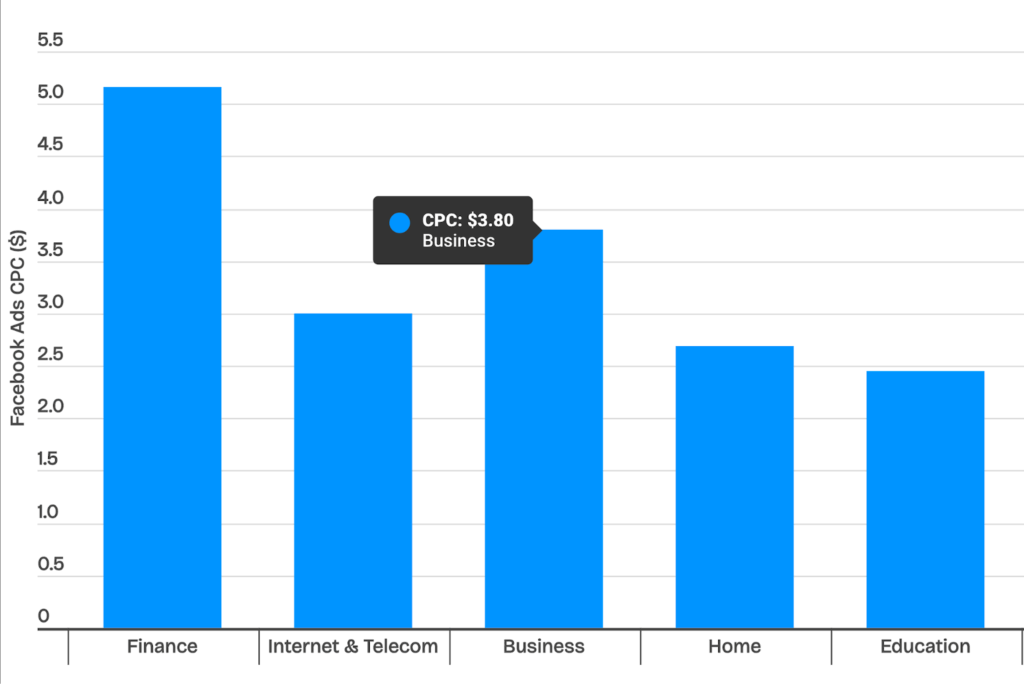
How does the Facebook ad auction system work?
Facebook’s ad auction chooses which ad to show based on a mix of your bid, the ad’s relevance, and its quality. When a spot opens up, the system picks the ad most likely to meet your objective at the lowest cost.
You’re charged just enough to win and not necessarily your full bid. This makes the system efficient and performance-driven.
Factors influencing Facebook ads cost
Ad quality & relevance: High-quality, engaging ads get better relevance scores and accordingly lower costs.
Learn what goes into the anatomy of Facebook ads here.
Target audience: A well-defined audience targeting reduces competition and improves ad efficiency.
Use LeadBridge to connect your CRM with custom audiences automatically to keep them up to date.
Check these useful integrations to automate your work.
Also, you can learn all you need to know about Facebook custom audiences here.
Bidding Strategy: Manual or automatic bids impact cost. Facebook rewards ads with high relevance and expected performance.
Facebook has a whole system to interpret these:
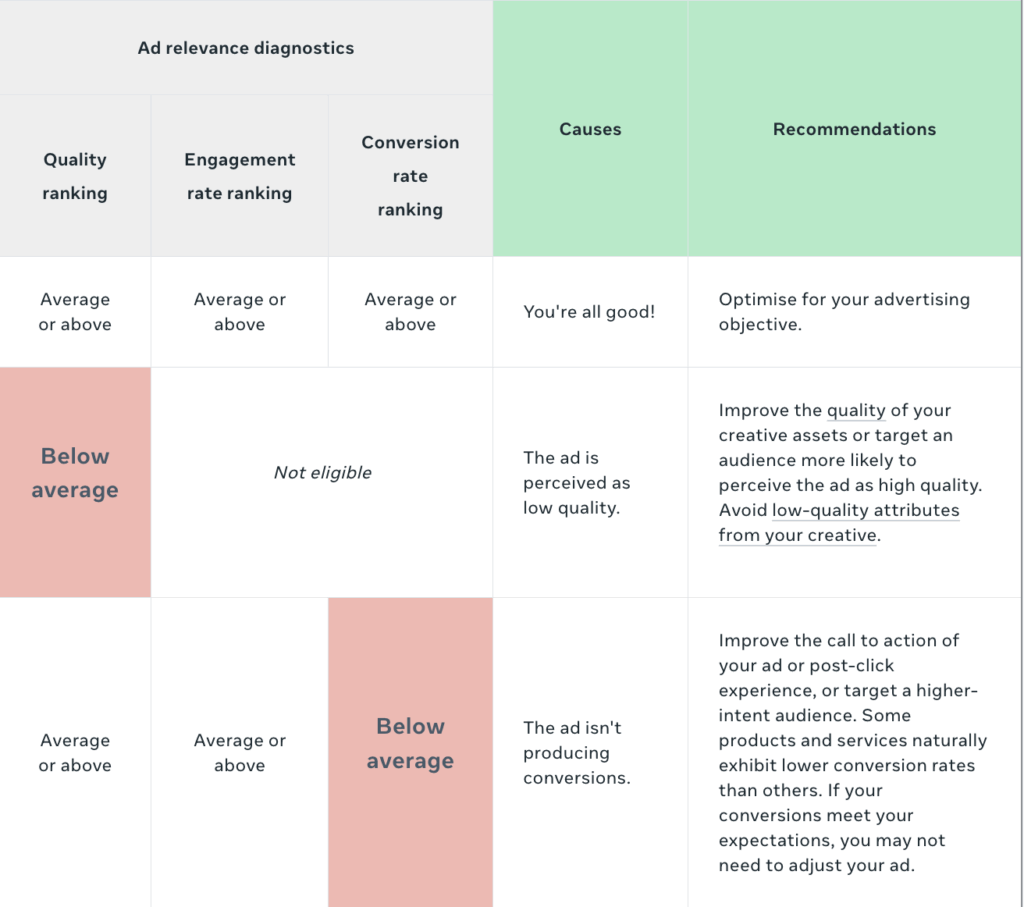
Ad Placement: Costs vary across placements. Test Facebook, Instagram, Messenger, and Audience Network to find the most cost-effective spots for your business.
Ad Objective: Your campaign goal (awareness, traffic, conversions) directly affects how much you’ll pay per result.
Strategies to reduce Facebook ads cost
1. Target the right audience
Facebook ad costs depend heavily on who you target. Broad target audiences often mean lower relevance and weaker results.
Instead, focus on focused demographics or custom audiences (people who have previously interacted with your business)

There are also lookalike audiences, which you can create from existing audiences of people similar to your audience who have not interacted with your brand yet.

2. Use the best ad creatives
Facebook is a visual platform and thrives on images and videos. Use analytics and CTR data to test creative quality. Low click-through rates often signal it’s time for a refresh.
Here’s how to level up your creatives:
- Customize creatives for different placements using Meta Ads Manager
- Adjust aspect ratios and focal points for better fit
- Use automatic optimizations to boost performance across Facebook’s platforms
3. Use the right type of ads
Facebook offers different ad formats and objectives. Each ad type has specific goals. For instance, if you need to generate low-cost leads for your business, lead ads would work best.
But remember, your ad’s format will also influence its performance and cost.
Check out these best Facebook lead ads CRM integrations for your marketing campaigns.
4. Use Video ads
Using videos in your ads also helps reduce advertising costs when running Facebook ads. Videos generate larger impression shares than other forms of content. This is why they have a cheaper cost per click. Usually, videos are cheaper and deliver a better ROI compared to images.
Here is an example of a good Facebook video ad from Try The World.

Here’s how to increase ROAS on Facebook ads.
5. Improve your ad quality and relevance score
More likes, comments, and shares signal strong ad relevance. It means that user interactions help lower your CPC. Aim for a relevance score of 8–10 to improve performance and get better results for less spend.
Instagram ads cost in 2025
With over 2.4 billion people using it every month, Instagram has established itself as one of the most powerful social media platforms out there.
There are different Instagram ad formats, such as photo ads, video ads, story ads, carousel ads, collection ads, explore ads, and Instagram shopping ads. While being a classic favorite, Instagram’s recent updates are even making it more accessible.
But before we break down how Instagram ad auctions work, let’s take a look at a few different types of ads.
Types of Instagram ads
Here’s a clear breakdown of all the available Instagram formats and placements:
Formats:
- Feed Posts (images, carousels, videos)
- Stories (disappear after 24 hours unless saved)
- Reels (short, vertical videos for discovery)
- Instagram Live (real-time video streaming)
- Guides (curated collections of posts or products)
- Collaborative Posts (shared between two accounts)
Ad/Content placements:
- Feed
- Stories
- Explore Tab
- Reels Feed
- Instagram Shop
- Profile Grid (for saved content or featured posts)
Now, take a look at this Instagram photo ad example from DC Shoes:

Instagram video ad example from Tours4Fun:

How does Instagram ads auction work?
You choose who you want to reach using filters like age, location, interests, and behaviors. You can also upload customer data (like emails or site visits) to create Custom or Lookalike Audiences.
Once your ad is eligible, it enters an auction. Instagram’s system calculates a total value score based on:
- Your bid: What you’re willing to pay
- Estimated action rate: How likely someone is to take your desired action
- Ad quality: Measured through user feedback and content standards
The ad with the highest score wins the auction and gets delivered. A high bid helps, but relevance and quality are just as important.
How can machine learning help reduce Instagram ad costs?
Machine learning helps lower Instagram ad costs by improving your ad’s chances of winning auctions without needing the highest bid. It does this by:
- Predicting action rates: It estimates how likely someone is to engage with your ad, helping you reach users who are more likely to convert.
- Evaluating ad quality: It assesses your ad’s relevance and quality using user feedback and content signals.
When your ad is seen as more relevant and high-quality, it can beat higher bids in the auction, meaning you pay less to reach the right people.
Factors influencing Instagram ads cost in 2025
Eight major factors affect Instagram ad costs in 2025. Let’s take a brief look at them:
- Bidding model and bid amount: Instagram uses CPC and CPM bidding. Average CPMs are $5–$10, and CPCs range from $0.50–$2. Higher bids increase your reach but also your costs.
- Audience targeting: Tighter or high-demand audiences cost more. Broader targeting is cheaper but may reduce conversion quality. Demographics and interests directly impact pricing.
- Ad quality and relevance: High-performing ads with strong visuals and clear CTAs cost less. Low relevance drives costs up. Instagram favors ads likely to get engagement.
- Ad placement and format: Feed ads are cheaper than Stories or Reels. Stories and Reels offer more engagement but at a higher cost. Explore ads are priced at a premium.
- Campaign objective: Objectives like conversions or leads often cost more but deliver better ROI. Instagram optimizes delivery based on your selected goal.
- Budget and duration: Larger budgets speed up learning and can lower costs over time. Smaller budgets may delay optimization and raise the cost per result.
- Seasonality and competition: Ad costs rise during high-demand periods like holidays. Competitive industries (e.g., fashion and real estate) also drive up prices.
- Landing page quality: A fast, relevant landing page improves post-click performance and boosts conversions, keeping ad costs down.
Strategies to reduce your Instagram ads cost in 2025
Effective strategies to lower your Instagram advertising costs this year:
- Use user-generated content (UGC): Ads with real customers get 4x higher click-through rates. It boosts relevance while lowering costs.
- Retarget warm audiences: People who’ve engaged with your site or profile convert at up to 70% lower cost than cold audiences.
You need automation to send your data between Meta and your CRM or other marketing tools for retargeting purposes:
- Run shoppable ads: Tagging products in posts can raise ROAS by 20%, helping you get more from the same budget.
- Pick the right campaign objective: Start with awareness or engagement before pushing for conversions. Cold conversion campaigns cost more and underperform.
Explore our popular Instagram lead ads integration, which you can use for free:
- Turn on automatic placements: Let Meta place your ads across platforms. This reduces competition and cuts Instagram-only costs.
- A/B test often: Test creatives, copy, and CTAs. Refresh ads every 4–5 days to keep performance high and costs low.
- Focus on ad quality: Strong hooks, visuals, and clear value lead to better relevance scores and lower delivery costs.
- Slightly broadened targeting: A wider but relevant audience lowers CPM by easing competition in narrow segments.
- Boost engagement: Ads that earn likes, comments, and shares cost less per impression. Use sharp visuals and strong CTAs.
Find out more about how to build email lists on Facebook and Instagram here.
- Avoid peak seasons or plan for them: Ad costs spike during holidays. Run campaigns early or budget accordingly.
- Use Meta Pixel: Track site visitors and retarget them. Warm audiences convert more easily and cost less.
Again, tracking your data can be impractical without automation for tools like Conversions API. Here are some of our top audience-targeting-relevant integrations:
Use LeadBridge to connect your CRM with custom audiences automatically to keep them up to date. Check these useful integrations to automate your work.
LinkedIn ads cost
LinkedIn captures around 32% of B2B social media ad spend, making it the second-largest channel for B2B marketers after Google.
Brands advertising on LinkedIn are 92% more likely to be seen as professional and 74% more likely to be perceived as intelligent.
Types of LinkedIn ads
LinkedIn offers various ad types you can use based on your ad objective and target audiences:
- Sponsored Content: Ads that appear in the LinkedIn feed, including:
- Single Image Ads
- Video Ads
- Carousel Ads
- Event Ads
- Document Ads
- Thought Leader Ads
- Click-to-Message Ads
- Connected TV Ads
- Article & Newsletter Ads
- Sponsored Messaging: Ads delivered directly in LinkedIn Messages:
- Conversation Ads (interactive, multi-path messages)
- Message Ads (direct, single-message format)
- Lead Gen Forms: Add forms to your ads to collect leads without leaving LinkedIn.
- Text & Dynamic Ads: Sidebar ads personalized by profile data (e.g., name, company).
Here are a few examples of some of the most popular sponsored content ads below:
How much do LinkedIn ads cost in 2025?
- CPC: Most pay $2–$4 per click (median $3.94); can exceed $10 in competitive sectors.
- CPM: Averages $3–$10 (median $6.37). 26% of advertisers pay $20+ for premium audiences.
- CPS (Sponsored InMail): Typically $0.25–$0.75 per send (median $0.70); high-value targets can cost $2+.
- Monthly spending: 48% spend under $500, the median is an average of $701, and 17% spend over $5,000.
The key cost drivers are mostly Audience targeting, campaign objective, ad format, and bidding competition.
Though pricier than other platforms, LinkedIn delivers strong value for B2B and decision-maker reach.
How does LinkedIn ads auction work?

Every time someone opens LinkedIn, ads compete in real time for a spot. The winner is chosen based on your bid and how relevant your ad is to the user. A higher bid helps, but relevance matters just as much, or maybe more.
Bidding options:
- Maximum delivery: LinkedIn handles bids to get the most results.
- Manual bid: You control how much you bid.
- Cost cap: Set a max average cost per result.
How to improve performance? Here is a quick checklist you might want to consider:
- Set realistic bids for your goals.
- Make your ads engaging and targeted.
- Use LinkedIn’s AI tools to optimize.
- Choose the right ad format and keep testing.
- Track results and adjust as needed.
The more relevant your ad, the less you may end up paying even if your bid isn’t the highest.
Now, let’s discuss the factors affecting the LinkedIn ads cost.
Factors influencing LinkedIn ads cost
Below are the top 5 factors influencing LinkedIn ad costs in 2025, so you can consider them before optimizing your LinkedIn advertising budget.
- Audience targeting: The more specific or high-value your audience (e.g., executives, niche roles), the higher the competition and the cost.
- Industry: Competitive sectors like tech, finance, and consulting typically see higher CPCs and CPMs.
- Ad format: Video, carousel, and Sponsored Messaging ads generally cost more than standard image or text ads.
- Campaign objective: Conversion-focused campaigns are more expensive than awareness or engagement goals.
- Ad relevance and quality: Engaging, well-targeted ads cost less by performing better in the auction system.
Strategies to reduce your LinkedIn ads cost
1. Select the right bid strategy
There are three bidding strategies for a LinkedIn ad campaign: the maximum bid, target cost bid, and manual bid. Choosing the right bid strategy can dramatically reduce advertising costs.
To have control over your CPC, you need to avoid using the automated bid strategy since it raises your cost per click. Therefore, the target cost bid strategy is the best way to handle your ad spending while maximizing your results.
2. Use LinkedIn Lead Gen forms
LinkedIn Lead Gen Form is one of the best advertising tools that help reduce LinkedIn ad costs.
These ads incorporate pre-filled forms. Once users click on the ad, the form contains personal information derived from their LinkedIn profiles. All they have to do is confirm and submit the form.
Marketers can add LinkedIn Lead Gen Forms to sponsored content campaigns and InMail, and also help reduce their overall spend.
Here is an example of a LinkedIn Lead Gen Form.

Read this guide to learn everything you need to know about LinkedIn Lead Gen Forms. Automating the process is key to optimizing your LinkedIn campaigns. Check out our top LinkedIn Lead generation form integrations below.
Remember that you can sign up for one of these integrations for free.
3. Improve the ad relevance score
The LinkedIn ad relevance score is based on your ad’s content relevance and how it compares to similar campaigns. Engagement metrics like click-throughs and social interactions actually tell LinkedIn how your audience perceives your content.
A high relevance score (showing strong audience approval) can lead to lower ad costs and vice versa.
4. Use retargeting
Retargeting is a tactic that can help you reach people similar to your existing audience. This system uses a code snippet to track people who have visited your website to retarget them with ads.
Did you know that retargeting ads increase trademark search behavior by 1,046%? Also, retargeting ads have 10X higher click-through rates than standard ads.
LinkedIn made retargeting possible with the aid of LinkedIn Matched Audiences. This tool helps retarget your website visitors.
This way, you can promote your products and services from your CRM or other marketing automation platforms. The account-based targeting feature also enables you to reach decision-makers at target companies.
Need better tracking metrics? Here’s how to boost your data tracking by setting up a LinkedIn Insight Tag.
5. Use LinkedIn metrics
LinkedIn provides key metrics to help advertisers track the performance of their campaigns. You can access this information at the top of the “Campaign Manager”, and right under the “Performance Chart” and “Demographics”, as shown below.

LinkedIn reveals your campaign’s metrics so you can see its potential and how to optimize its performance. These metrics include data about high-converting audiences, average CTR, reactions, comments, shares, follows, likes, clicks, and more.
Use this information to evaluate the performance of your ads by improving your relevance score. Ultimately, this helps reduce the cost per click and cost per lead.
Pinterest Ads cost in 2025
Pinterest Ads’ costs are decided by an auction system. This means there is no fixed price. You set a maximum bid for your campaign goal, which could be engagement, clicks, or impressions. Like other ads, the audience you target and the format you use also affect your ads’ cost.
That said, Pinterest ad costs in 2025 are generally low, making it a cost-effective option for many brands.
- CPC averages between $0.00 and $0.20, though competitive niches can see $1.50 or more.
- CPM typically falls between $0.00 and $1.50, with brand awareness campaigns costing up to $5.
- CPA ranges from $0.00 to $8.00 for most, though some pay $16+, depending on industry.
- Budgets vary. Nearly 60% of advertisers spend under $500/month, but 19% go beyond $5,000.
As a rule of thumb, more precise targeting and competitive sectors increase costs, while strong visuals and broad reach help keep them down.
Pinterest offers various ad types, including:
- Promoted Pins: Look like regular Pins but labeled “Promoted”; turn organic when saved. Great for awareness and traffic.
- Shopping Ads: Pull products from your catalog with direct links to product pages. Ideal for e-commerce and conversions.
- Video Ads: Short autoplay videos in-feed (6–15 sec). Available in standard or max-width. Best for engagement and brand lift.
- Carousel Ads: Swipeable images or videos, each linking to a different page. Good for product showcases or visual stories.
- Collection Ads: Hero image/video with smaller product images below. Mobile-only, great for showcasing product lines.
- Idea Pins: Multi-page Pins with video, images, text, or lists. Useful for how-tos, tutorials, and storytelling.
- Try On Product Pins: Use AR to let users virtually try items like makeup. Boosts confidence and conversions.
- Showcase Ads: Swipeable interactive cards linking to brand or product info. Each card can be saved individually.
- Quiz Ads: Mobile-only, interactive multiple-choice format. Delivers personalized results with outbound links.
- Premiere Spotlight Ads: Premium placement on home or search for a full day. High-impact for major brand pushes.
It’s important to make sure your ads’ creatives are aligned with the best practices for Pinterest ads.
How Pinterest Ad delivery works
In 2025, Pinterest ad delivery will be powered by AI. It can essentially prioritize showing your ads to users most likely to engage or convert with outstanding accuracy.
The system looks at interests, past behavior, keywords, and how well your Pins perform to rank and deliver content.
Tools like Performance+ automate audience targeting and creative optimization, helping reduce setup time and improve CPC and CPA. Visually rich content, especially video, gets priority, and ads with shopping features are boosted for users showing purchase intent.
The system constantly learns from user interactions and campaign results, improving ad delivery over time for better performance and ROI.
Factors affecting Pinterest Ads cost in 2025
Optimized Pinterest Ads result in higher engagement while also having more efficient spending and potentially lower costs over time.
- Specificity of target audience
The more specific and narrower targeting can lead to higher costs due to increased competition for a specific demographic. At the same time, this will increase the engagement your ad can have, which will decrease the costs, given that your campaign is perfectly optimized.
- The Ad’s format and creatives
Different ad formats (e.g., video vs. standard pins) as well as the creative quality are huge factors in your Pinterest ad costs. This is because they affect engagement and, consequently, cost.
- Seasonality and demand
Like other advertising platforms, Pinterest ads costs can change based on the time of year with peak seasons seeing higher ad costs. Other times these price fluctuations are caused by a trend or a product’s popularity which will increase the demand and hence the costs.
- Bid strategy and budget
The choice you make between automated and manual bidding strategies can impact how efficiently your budget is spent.
- Ad performance
The higher your ad’s engagement rates are, the better your ad relevance scores. This can potentially reduce the cost per action over time.
How to reduce Pinterest Ads costs in 2025
Now let’s talk about some action-based strategies to reduce Pinterest Ads costs and win over the competition in 2025:
- Optimize your audience targeting
Better ad targeting means focusing on a narrow audience. This might be specific demographics, interests, and behaviors to reach the most relevant audience.
In addition to cutting down on wasted impressions, you’ll increase your ad’s effectiveness and reduce costs.
- Optimizing your ad’s creative
Creating engaging, high-quality visuals and copy that resonate with your target audience is a sure strategy. Test different creative elements to see what gets the best performance at the lowest cost.
- Selecting the right ad format
Using an ad format (e.g., standard pins, video pins, carousel ads) is a Pinterest best practice that’s often overlooked.
The right ad format matches your audience’s expectations while delivering your message. Creating a relevant and engaging ad naturally becomes the most cost-effective option for your campaign goals.
Check out this complete guide to Pinterest Lead Ads.
- Analyze your ad’s performance
Regularly review your performance metrics to find out which one of your ads is underperforming.
The weak performance might also be due to the targeting criteria. After pinpointing the issue, adjust or pause these parts to move your budget towards higher-performing options.
- Leverage Automated Bidding
Pinterest’s automated bidding strategies can take a lot off your hands. It basically optimizes your campaign for the best possible results within your budget constraints.
This option can also help manage costs by focusing on achieving specific objectives, like conversions or engagement.
Want to put your campaigns on autopilot? Build your integrations now:ow:
Snapchat Ads cost in 2025
Snapchat’s ad pricing in 2025 varies based on multiple elements, including the type of ad, targeting options, competition level, and campaign goals.
Snapchat offers a variety of ad types:
- Single Image/Video Ads: Full-screen vertical ads between content. Great for awareness, traffic, or remarketing. Length: 3–180 seconds.
- Story Ads: Branded tiles in the Discover feed that open into a series of Snaps. This is ideal for showcasing products, answering FAQs, or sharing offers.
- Collection Ads: Feature multiple products in one ad. Users can tap on items to shop. It’s perfect for retargeting high-intent audiences.
- Commercial Ads: Unskippable vertical videos (3–6 seconds standard, up to 180 seconds extended). Best for delivering key messages.
- AR Lenses: Interactive, branded filters and effects that boost engagement and brand recall.
How much do Snapchat ads cost?
Below is an overview of the latest average rates and critical considerations:
Cost per 1,000 Impressions (CPM): The typical CPM falls between $3.03 and $10.47 as of early 2025. In January, the average was around $8.85, though some reports place it slightly higher at $9.63.
Cost per Link Click (CPLC): On average, advertisers pay between $1.75 and $1.93 per click. In some cases, lower rates of approximately $1.02 per click have been reported.
Click-Through Rate (CTR): Snapchat campaigns generally see CTRs ranging from 0.46% to 0.94%, depending on targeting and creative quality.
Minimum daily budget: A minimum spend of $5 to $5.15 per day is required to run ads on the platform.
Premium ad format pricing:
- Sponsored AR Lenses: High-end campaigns start at $450,000 to $700,000.
- Live Story Ads: Require a minimum spend of $50,000 or more.
- Snap Forecast Ads: Typically cost between $100,000 and $400,000.
How Snapchat ad delivery works in 2025
Snapchat Ads are now powered by advanced AI and machine learning. The platform’s algorithm figures out who’s most likely to engage with your ad (whether that means swiping up, installing an app, or making a purchase) and delivers your content to those users.
Behind the scenes, Snapchat regularly monitors engagement, creative performance, user behavior, and real-time trends. It then uses those findings to adjust where and when your ads appear to get you the best return.
What can control Snapchat Ad costs?
If your ads are optimized, they’ll usually perform better and cost less over time. But a few key things influence what you pay:
- Auction-based pricing: Snapchat operates on a goal-driven auction model. The more competition, the higher the cost, especially during busy seasons.
- Creative quality: The better your ad looks and performs, the cheaper it is to show. Snapchat rewards relevance and engagement.
- Seasonality & demand: Costs increase when more brands compete for attention.
- Ad format: High-impact formats like AR Lenses cost more than basic Snap Ads, but they can also deliver stronger results.
Tips to lower your Snapchat Ad costs
Want better performance without overspending? Here’s a three-dimensional strategy about how to stretch your budget further:
- Practice good audience targeting
One of the easiest ways to make your ad budget go further is to focus on reaching the right people. Narrow down your audience by age, interests, behaviors, or location.
This way, you’re not paying to show ads to people who aren’t likely to care. The more relevant your audience, the better your results.
- Work on your creatives and formats
Your ad design and format matter a lot. Use eye-catching visuals and messages that really speak to your audience. Don’t be afraid to test different styles. What works for one group might flop with another.
Also, choose the format that fits your goal. For instance, AR Lenses are great for fun, interactive engagement, while Collection Ads are ideal for showcasing products and driving purchases.
- Optimize with tools and data
Always keep an eye on your campaign performance. If something’s not working, adjust or pause it and put more budget behind what is.
Snapchat’s automated bidding can also help. It manages your ad spend for you, aiming for the best results based on your goals.
Want to go a step further? Use tools like LeadsBridge to automatically capture and follow up with leads, so you get more value from every click.
Types of ad costs by channel
Advertising costs can vary greatly depending on the channel you choose. Let’s take a look at some of the most popular advertising channels.
Ad costs vary depending on the platform and strategy you choose. Here’s a quick look at what you can expect across the major digital marketing channels in 2025:
PPC (Pay-Per-Click) ads
These ads charge you only when someone clicks. On Google Search, clicks typically cost $1–$5, but can go much higher in competitive industries.
On the Google Display Network, it’s about $0.66 per click. CPMs (cost per 1,000 impressions) usually fall between $4 and $10.
Monthly budgets range from $100 to $10,000+, depending on your goals and business size. Your costs will depend on keyword demand, competition, and ad relevance.
Social media advertising
The platforms use pricing models like CPC, CPM, and CPA. Facebook ads usually cost $0.26–$0.50 per click, while Instagram range from a few cents to around $0.70. LinkedIn is pricier, averaging $2–$3 per click.
YouTube and Pinterest are on the lower end, starting as low as $0.01. CPMs typically range from $6 to $14.
Small businesses might spend $650–$2,500 a month, while multi-channel strategies can total $10,000–$25,000 annually. Costs depend on platform, audience targeting, and ad quality.
SEO (Search Engine Optimization)
This doesn’t charge per click but instead requires an upfront investment in organic visibility.
Monthly retainers average $1,000–$2,500, and hourly rates usually run between $50–$100. While results aren’t instant, SEO delivers long-term value by growing unpaid traffic over time.
Email marketing
This channel is often the most cost-effective channel, delivering around $36 for every $1 spent.
Monthly costs can range from $9 to over $1,000, depending on your email list size and the tools you use. Your success here depends heavily on your list quality, segmentation, and how well your emails are crafted.
Content marketing
Content marketing can be done in-house or outsourced. Costs vary based on how much and what type of content you produce, like blogs, videos, or infographics.
Monthly budgets typically range from $1,000 to $20,000 or more. While it takes time, content marketing helps build brand authority and steady organic traffic.
How much is advertising for a small business
The monthly online advertising costs for small businesses depend on the industry and how much work marketers want to get done in-house compared to hiring an outside agency.
Most small businesses invest $10,000–$50,000 annually in marketing, roughly 10–13% of their total budget. On a monthly basis, ad spend usually falls between $1,000 and $10,000, with many allocating $1,000–$5,000 specifically to digital ads.
Final thoughts
We discussed the advertising costs on the seven major platforms: TikTok, Google, YouTube, Facebook, Instagram, LinkedIn, Snapchat, and Pinterest. Since many factors influence ad costs, there is no fixed price for advertising on the platforms.
These factors include the ad quality and relevance score, niche industry, target audience, bidding strategies, etc. However, a combination of these elements determines how much your ads will cost you.
The good news is that there are ways to reduce your advertising costs, such as increasing the quality and relevance of your ads, using the right ad format and bid strategy, targeting the right audience, and testing different ad creatives.
Using the right tools, such as LeadsBridge automation integrations, can also optimize your ads and reduce advertising costs.














